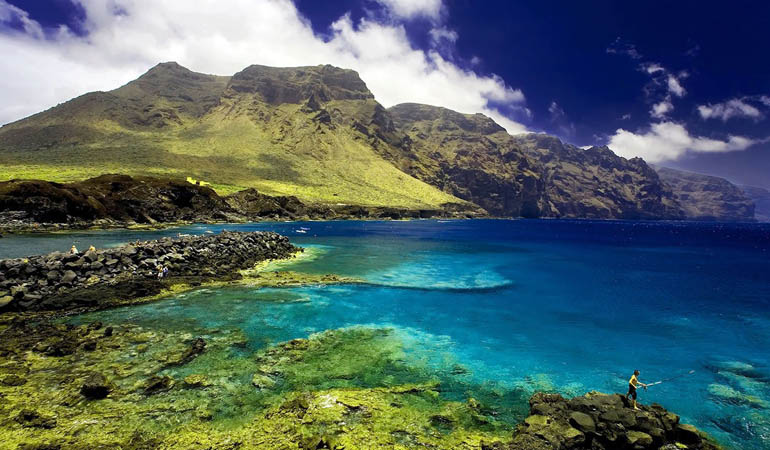• The lagoon
The town proudly named San Cristobal de la Laguna is the quintessence of Canarian style, charm and atmosphere, the better, that it is a university center. Its old town was in 1999 r. inscribed on the UNESCO World Cultural and Natural Heritage List. The town is famous for being the wettest in Tenerife – it's rainy here even then, if the sun is shining a few kilometers away.
• Teide National Park
This is probably the most common, on the beach of Los Cristianos, visited place on the island, however, it is only crowded there, where you can get there by car – few tourists decide to go on a hiking trip into the park, where you can see different colors (from black, through red, yellow to green) and lava types. The park changes depending on the season – in late spring it explodes with a true riot of colors, in summer it seems like a scorched desert, and in winter it covers with a snow cover.
• Guimar
Nice white town with a church, a graceful square and traditional buildings, however, this is not why it is popular with tourists. Most people come here for that, to see… pyramids. Who is expecting the Egyptian style pyramids, will be disappointed - the buildings in Guimar resemble those erected in Peru and Mexico. The six rectangular, stepped structures that kept many archaeologists awake at night, who initially argued, that they are merely piles of stones laid by farmers.
Tenerife is also the most famous and least known of all the islands of the archipelago, which has become famous as a beach destination in Europe, perfect for those looking for sun and all-night parties. Due to this "patch", travelers often avoid it, and this is a mistake. The island has much more to offer than the tourist resorts of Playa de las Americas y Los Cristianos. Just recall, that's right here, and not in the Pyrenees, the highest peak of Spain is rising, measuring 3718 m n.p.m. volcano Teide; there are also beautiful mountain ranges of Teno and Anaga, foggy Tertiary laurel forests, lava fields or truly Canarian towns, such as La Laguna, La Orotava or Garachico. The always sunny south of the island is actually rather the domain of sunbathers, however there are places, where it is difficult to meet a living spirit and where nature has won over mass tourism.
In one word: Tenerife is big enough, to accommodate so vacationers, as well as backpackers, leaving enough space for the inhabitants of the island.
Tenerife saw the light of day some 7 million years ago, when the three islands of Anaga emerged from the sea, Teno i Adeje, connected 4 million years later by Edificio Canadas, which has risen above 6000 m n.p.m. 200 thousand. years ago it collapsed, creating a mighty caldera, in the middle of which the mighty Teide volcano grew – the most recognizable symbol of Tenerife.
The Spaniards began the conquest of the island in 1494 r., yet fierce resistance (They managed to break the iuanczów only after two years, in the famous Second Battle of Acentejo. The Guanches were either murdered or deported to Europe as slaves, and a handful of survivors assimilated quickly. Meanwhile, the Spaniards settled on the island for good, establishing its new capital, La Lagune, w 1496 r.
Under Spanish rule, the island flourished as one of the most important stopping places on the way to and from South America. Cane sugar and carmine were exported on a large scale from the ports of Tenerife (a natural dye obtained from aphids living on the fig opuntia). The times of prosperity were also associated with numerous pirate raids and the famous and unsuccessful attack of the British general Horatio Nelson on Santa Cruz de Tenerife (he lost his right arm in it).
The situation in Tenerife began to worsen as interest in carmine declined, which even got worse, when General Franco took power in Spain, which was stationed on the island for six months before the start of the civil war (II-VII 1936 r.). In years 50. XX w. the situation has become so dramatic, that many people decided to illegally emigrate to Cuba and Venezuela. In recent years, emigrants and their descendants have started to return to Tenerife en masse, where tourism makes people prosperous. This adds a special touch to the island, Latin charm and atmosphere, which you can see in the music, eating and, above all, preserving the tinerfenos.
To save the day, Franco decided to create a paradise for tourists on the islands. Initially, tourism was concentrated mainly around Puerto de la Cruz, however, over time, tourism slowly began to shift to the sunniest southern part of the island, which is currently visited by approx. 10 million tourists from all over the world.

Hi, I have a question where the first photo above the description was taken?greetings.